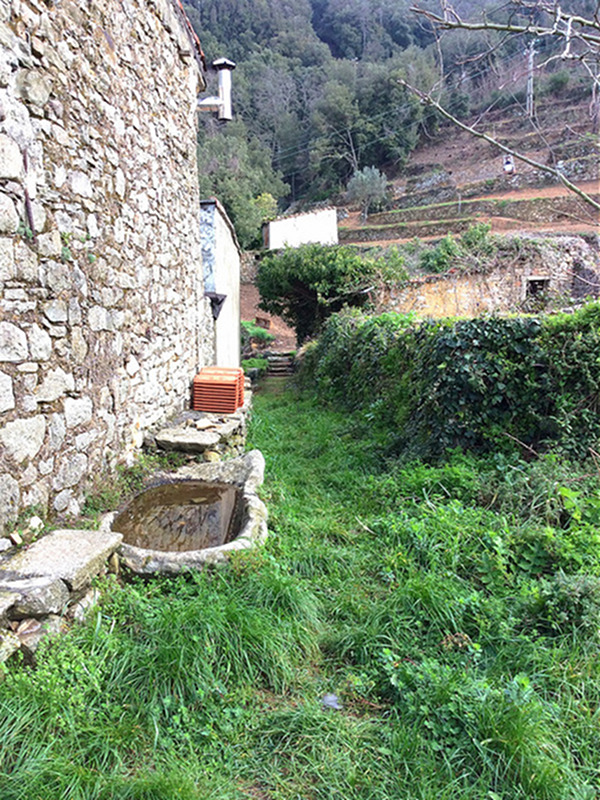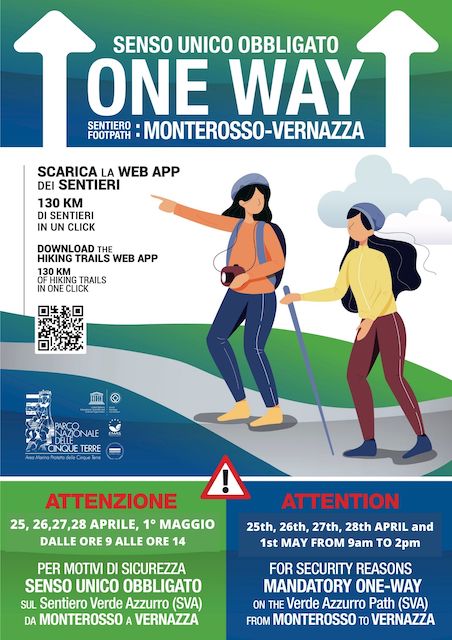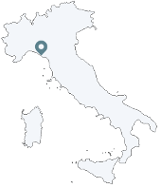Itinerary of the Ancient settlements

(photo by: PN Cinque Terre)
 Download KMZ
Download KMZen
Tourist, Hiking, Skilled, Closed
Nearby a mill now rearranged as house take a stone stairway from where you can see the top of Mount Verrugoli.
After a stretch characterized by the Riomaggiore's typical bedded sandstones, the trail continues across an area of Turbiditic sandstone where a large boulder can be spotted in the clearing of a small abandoned quarry that supplied building stone for houses and walls in ancient times.
In the spaces between the stones of the walls grows the Mediterranean clubmoss (Selaginella denticulata), a small spikemoss surprisingly similar to its 200 millions years old progenitor.
Climbing among cultivated terraces and vineyards, partly abandoned and now colonized by Mediterranean scrub, the trail meets the provincial road SP 370 and continues uphill after crossing it nearby a small stone bridge over the stream.
Despite the low altitude, chestnut trees are very common in this area, proving that such tree was an important element of the rural economy. The trail passes by a small tabernacle and keeps ascending gently among abandoned fields and woods, then the last stretch runs level among scattered rural dwellings before arriving at the Sanctuary.
From the wide forecourt of the church, hikers can enjoy a stunning view of the Cinque Terre coastline and the Mesco promontory to the west, and Tramonti, the rock called Ferale and the islets of Palmaria and Tino.
The Sanctuary of Our Lady of Montenero was probably built between 11th and 13th century, though the first reliable records of its existence date back to 1335. The whole complex was restored in 1847 after the designs of Architect Piaggio. The traditional festivity of Our Lady of Montenero, depicted in a 16th century painting, is celebrated on the day after Pentecost.
According to a legend, the sacred image of the Virgin was buried by the faithful to save it from the Barbary pirates' raids in medieval times, and when it was finally unearthed a spring appeared in the place where it was hidden.
From the back of the court the detour 593C leads down to the provincial road SP 370, while trail SVA continues passing by the local monorail (the only possible mechanization for agriculture in this area, introduced in the 1980s) and going uphill through a shrubland of holm oaks, blackthorn (Prunus spinosa), heather and gorse. After a flat stretch nearby a group of scattered houses and fields, it climbs up again until the fork in the place called Casarino, where it turns right and continues on flat ground.
Before reaching the ancient settlement of Lemmen the trail goes past Costa di Serra, a hill where grapevine is still traditionally grown. The first records of the small hamlet of Lemmen, which houses are now partly abandoned, date back to 1251, when men from the villages of "Villa Cazeni et Montenigro, Cacinagola, Ceroco e Lemina" pledged allegiance to the Republic of Genoa in the war against Pisa.
The trail continues flat passing by the small chapel of Saint Bernard, near which lies a large sandstone trough, then in a short while it turns left and starts ascending among vineyards and woods of holm oaks and pine trees until the Telegrafo hill pass. Nearby the hill pass a wooded area called "Palestra nel Verde" is provided with outdoor gym equipment.
From the hill pass the trail shares a stretch of about 20 min. walk with the Alta Via delle Cinque Terre until it reaches the chapel of Saint Anthony (510 meters a.s.l.), where there is also a picnic area and a fountain. From here the itinerary continues on trail 504, going downhill through a wood of pine trees, chestnut trees and downy oak. The undergrowth is made of different Mediterranean plants and shrubs such as strawberry tree (Arbutus unedo), sage-leaved rock-rose (Cistus salviifolius) and gorse.
Layers of Turbiditic sandstone can be seen alongside the road. The trail reaches a clearing where there is a prehistoric Menhir about 2,5 meters tall, dating back to the Bronze Age, probably having the function of an early calendar. In the clearing, a dry stone wall (called "Posa Grande") was used by peasants to lay the heavy loads carried on the shoulders, and the small grotto nearby served as shelter.
From the clearing the trail descends on the left where it takes a shady stone stairway among holm oaks, shrubs and cork oaks.
After crossing a dirt road the path divides: the branch to the right (trail 536) leads to Monesteroli, while trail 504 continues to the left along the plain called Veo, heading east, passing by some vineyards and a mixed wood of oaks. The trail then leaves the terraced plain and enters a wood of holm oaks where, in the vicinity of the fountain of Nozzano, meets trail 535 (Campiglia - Fossola). The fountain was built by the Napoleonic army in the early 19th century.
The itinerary can now take a detour to the hamlet of Schiara, keeping on trail 504 as it descends along the terraced fields of Campodonico and down the stone stairway that passes near the monorails used by winemakers (who produce Sciacchetrà and white wine) in the grape harvest.
The stretch of trail climbing down to Schiara runs mostly on stone stairs, so steep that they seem to plunge into the sea. The small settlement of Schiara extends around the church of Saint Anthony and its square, where the cobblestones are carved with the names of the stoneworkers, an activity that in the past was tightly connected to the rural life in this area. Past the last houses of Schiara the path descends very unevenly toward the sea, in an area subject to several landslides.
After this immersion in the scent of Mediterranean shrubs and in the pristine blue of the sea, heading back to the fountain of Nozzano the itinerary can continue in two directions: eastward to Campiglia or westward to Monesteroli and Fossola.
Toward Campiglia
From the fountain the trail follows the stretch of path shared between 504 and 535 until it meets the paved road that connects Saint Anthony at Telegrafo to Schiara. After walking it a few meters uphill, trail 535 divides from the road and leads to Campiglia, offering a beautiful sight over the sea, from the cliffs of Schiara to the Palmaria island, and over the cultivated terraces below. The trail then goes through a wood until it reaches the terraced vineyards just before the village of Campiglia.
Toward Monesteroli and Fossola
From the fountain trail 535 descends gently among the vineyards, with a view over the coast of Schiara and the Ferale rock, then meets trail 536 that connects trail 504 to the hamlet of Monesteroli. A stretch of cobbled track going through uncultivated fields and vineyards grown on low trellis leads to the beginning of the so called "Scala Grande", a stunning structure made with sandstones that proves the ability of the rural engineers of the past. The stairway was built with blocks of different size, without mortar or cement. It climbs down to the settlement of Monesteroli, a few meters over the shore, from where the descent would continue to the sea, along a stair that is now mostly affected by landslides.
Climbing back to the first landing on the stairway, the itinerary takes a turn to the left on trail 535 heading west, through Mediterranean vegetation, toward the Reboi gully.
The trail passes along the valleys of Castigliola and Lama, on almost flat ground overlooking the beach called Nacché, before entering a cultivated area just ahead the first dwellings of Fossola. After passing by a group of scattered houses, a steep stairway leads across the gully of Fossola until reaching the chapel of the Guardian Angel, where it meets trail 534 (Sant'Antonio-Fossola). Climbing uphill on a stairway the trail reaches the parking area of Fossola, from where it continues along the paved road that connects the hamlet to the provincial road SP 370. The road ends nearby the parking on the SP 370 where there is a wine-tasting bar run by the Cinque Terre co-operative winery, and a bus stop served by the Park's buses to Riomaggiore and Biassa (some routes end at Telegrafo hill pass).
Points of Interest:
- Localities crossed: Riomaggiore, Casarino, Lemmen, Crocetta, Telegrafo hill pass, S.Antonio, Nozzano, Campiglia, Monesteroli, Fossola
- Archaeological evidence: Cavaneo, duplicate of the sandstone stele "Lapis Terminalis"
- Ethnographical evidence: Votive tabernacle of Madonna di Montenero, other votive tabernacles, stone altar, sandstone basin in Lemmen
- Architectural, historical and artistic Beauties: Ancient stone bridge, Sanctuary of Madonna di Montenero, Chapel of Saint Bernard, Chapel of the Guardian Angel, fountain of Nozzano, church of Saint Catherine of Alexandria (Campiglia), Monesteroli stairway called "Scala Grande"
- Services and shops: Riomaggiore, Telegrafo (seasonal), Sant'Antonio (seasonal), Campiglia
- Points of water: Riomaggiore, Sant'Antonio, Nozzano (potability must be verified), Campiglia
More information at mappe.parconazionale5terre.it:
We remind you that the Cinque Terre National Park's trails must be always walked with good climatic weather conditions, with adequate shoes and only by persons having a good hiking experience.














